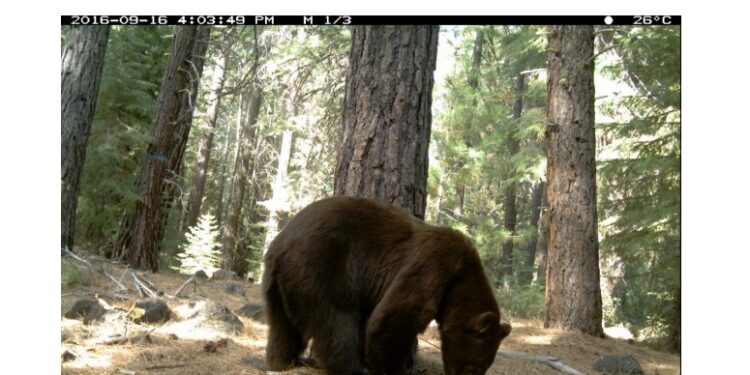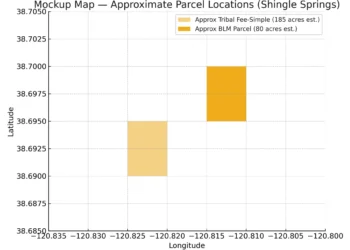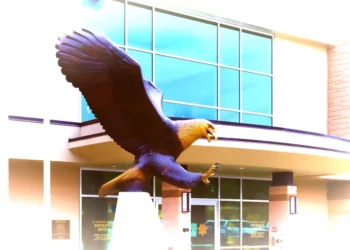South Lake Tahoe, Calif. (May 19, 2024) – As the sun dips behind the Sierra Nevada mountains, the quiet serenity of South Lake Tahoe is occasionally punctuated by a different kind of rustle: the stealthy footsteps of a black bear. Encounters between these majestic creatures and humans have become increasingly common, prompting the California Department of Fish and Wildlife (CDFW) to take decisive action. They are crafting a new Black Bear Conservation Plan aimed at minimizing conflicts and preserving the delicate balance between human habitation and wildlife.
The picturesque Lake Tahoe Basin, renowned for its stunning landscapes and outdoor recreational activities, has been identified as a particular “hot spot” for these interactions. CJ Russell, a resident of South Lake Tahoe, experienced this firsthand when a black bear and her cub made themselves uncomfortably at home right outside her apartment.
“She broke in there. She broke this,” Russell recounted, pointing to the damage inflicted on her fence and backyard shed. The proximity of her encounter left a lasting impression. “Probably two feet. Pretty close,” Russell said, her voice tinged with lingering fear. “She had slapped her paw down and huffed at me,” she added, recalling the bear’s intimidating display.
Seeking assistance, Russell turned to the BEAR League, a local nonprofit dedicated to keeping bears wild and safe. Founded by Ann Bryant, the organization aims to educate the public on coexisting with these animals while ensuring their natural habitat remains undisturbed.
“In the 30 years since I’ve been here, there’s been an influx of more and more people,” Bryant explained, highlighting the correlation between the growing human population in Tahoe and the increase in bear sightings. The BEAR League’s call logs reflect this surge, with more residents and visitors seeking guidance on how to handle bear encounters.
Bryant described the growing problem of bears seeking refuge under houses during the winter. “The first year that we did this, it was one mama bear with three yearling cubs under a house. Now, it’s over 100 bears every winter,” she said.
CDFW officials are acutely aware of these issues. Their latest data reveals a stark increase in reported human-bear encounters, averaging 1,678 annually in 2021 and 2022, compared to 674 per year from 2017 to 2020. This rise has been attributed to more rigorous incident reporting and an expanding human footprint in bear territories.
Alexia Ronning, a human-wildlife conflict specialist with CDFW, emphasized the role of improper food storage in attracting bears. “A lot of common things we see are people leaving food in their vehicles or coolers out on the back porch. Bears break into that. Not cleaning your grills or having bird feeders—these are all attractants,” she said.
To mitigate these conflicts, the BEAR League and local residents have adopted various preventive measures. The league loans out electric doormats that give bears a harmless shock, deterring them from returning. Some homeowners, like Kathi Zollinger, have installed electric wires around entry points to keep the bears at bay.
“My first bear encounter, I was living in the north shore,” Zollinger said. “Ran away from it. When I saw it, it was at night and I was scared to death.” Now, equipped with knowledge and experience, Zollinger volunteers with the BEAR League, helping others like Russell to coexist safely with their ursine neighbors.
The state’s updated Black Bear Conservation Plan, open for public input until June 14, aims to conserve black bear populations while providing opportunities for hunting, viewing, and education. A notable shift in the plan is the prioritization of non-lethal conflict mitigation measures, which has led to a decline in the number of bears killed under depredation permits—from 100 in 2017 to just 30 in 2022.
“Though these trends may partly reflect changes in human attitudes toward black bears, there was also a significant policy shift in 2022,” the draft plan states. This shift underscores CDFW’s commitment to humane and sustainable wildlife management practices.
As the plan undergoes final reviews, the hope is that education, community involvement, and thoughtful policy will pave the way for a harmonious coexistence between the residents of South Lake Tahoe and their wild neighbors. For Russell and many others, these efforts offer a sense of security and a reminder that, in the heart of bear country, respect for wildlife is key to living peacefully alongside nature.










